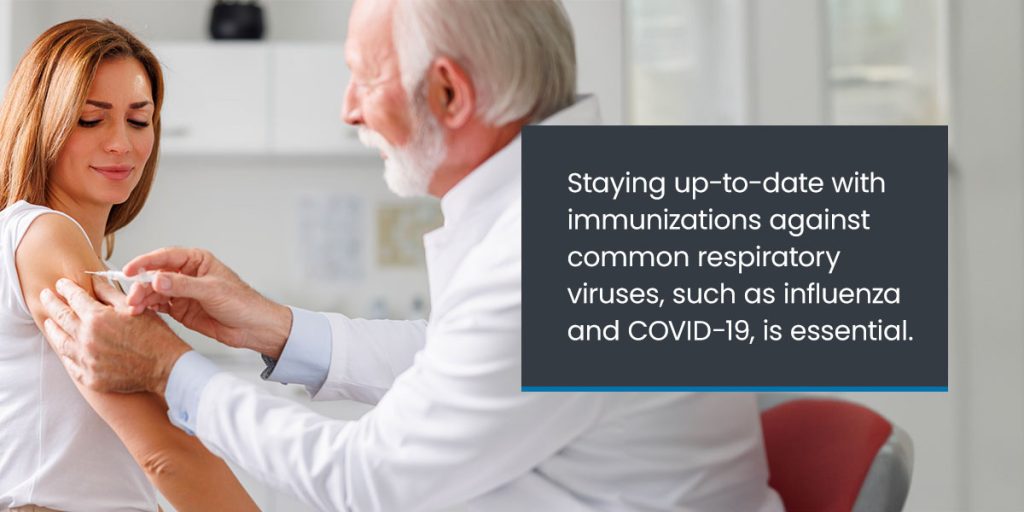Recurrent respiratory infections pose a persistent health challenge that can impact one’s daily life. Some infections can potentially lead to serious complications, such as bronchitis or pneumonia. As such, understanding the underlying causes behind a recurrent respiratory infection becomes critical.
Medical and laboratory professionals rely on advanced diagnostic tests to pinpoint the specific pathogens responsible for these infections. This knowledge can help guide health care professionals and researchers in creating effective care and management strategies.
Etiologies of Recurrent Respiratory Infections
Recurrent respiratory infections encompass a spectrum of pathogens and underlying conditions that predispose some individuals to frequent bouts of illness. Identifying these etiological agents allows for targeted diagnostic approaches and tailored therapeutic interventions.
Health care professionals may mitigate the impact of these conditions on patients’ health and quality of life by addressing the specific causes of recurrent lower respiratory tract infections (LRTIs) and upper respiratory tract infections (URTIs).
1. Risk Factors
Several risk factors may increase the likelihood of an individual experiencing recurrent respiratory infections. These factors range from environmental influences to individual demographics, lifestyle choices, and immune system status. The primary risk factors include:
- Frequent contact with infected individuals: Regular exposure to infected people in crowded environments, such as medical settings, schools, or daycares, increases the risk of infection.
- Smoking and secondhand smoke exposure: Tobacco smoke compromises respiratory epithelium, impairing mucociliary clearance and immune function.
- Environmental pollutants: Exposure to air pollutants like particulate matter and chemicals can irritate airways, increasing susceptibility to infections.
- Poor nutrition: Inadequate intake of essential nutrients and poor dietary choices compromise immune function, making individuals more susceptible to infections.
- Seasonality: Recurrent respiratory infections often peak in colder months, such as autumn and winter.
- Age: The elderly and children are more susceptible due to immature or declining immune systems.
2. Anatomic Problems
Certain anatomic issues can also contribute to recurrent respiratory infections. These may include:
- Nasal obstructions: Structural issues like a deviated septum or nasal polyps can obstruct airflow, trap pathogens, and lead to chronic sinusitis or URTIs. Molecular diagnostic tools can help identify specific pathogens causing these infections.
- Tonsillar hypertrophy: Enlarged tonsils can harbor bacteria and viruses, causing recurrent tonsillitis or contributing to LRTIs.
- Adenoid hypertrophy: Enlarged adenoids can obstruct nasal passages and impair Eustachian tube function. This hypertrophy can predispose to chronic otitis media and LRTIs.
- Laryngeal and tracheal abnormalities: Malformations or strictures in the larynx or trachea can disrupt airway clearance mechanisms, increasing susceptibility to respiratory infections.
- Bronchial abnormalities: Conditions like bronchiectasis or bronchomalacia predispose to recurrent LRTIs. These conditions impair mucociliary clearance and promote bacterial colonization.
Understanding these problems often requires interdisciplinary approaches involving otolaryngologists, pulmonologists, and infectious disease specialists. Advanced molecular diagnostic techniques, such as multiplex polymerase chain reaction (PCR) panels, can provide comprehensive pathogen identification, aiding in the precise management of these conditions.
3. Primary Immunodeficiency
Primary immunodeficiency disorders associated with recurrent respiratory infections include the following:
- Common variable immunodeficiency (CVID): This immune disorder is characterized by low levels of immunoglobulins — particularly immunoglobulin G — and poor antibody response. CVID leads to susceptibility to bacterial and viral infections, including respiratory tract infections. Molecular diagnostics can identify specific genetic mutations associated with CVID.
- Selective immunoglobulin A deficiency: Individuals with very low levels of immunoglobulin A are more susceptible to respiratory infections, particularly sinus and lung infections.
- Severe combined immunodeficiency (SCID): This is a group of rare genetic disorders where there is a severe deficiency in T cells, B cells, or both, resulting in a profound immunodeficiency and susceptibility to recurrent severe infections, including respiratory tract infections. Genetic testing and molecular diagnostics are crucial for accurate diagnosis.
- DiGeorge syndrome: A deletion in chromosome 22 may lead to abnormalities in thymus development and T cell function, predisposing individuals to recurrent infections, including respiratory tract infections.
These conditions require specialized laboratory testing and clinical evaluation for accurate diagnosis and effective management. Collaboration with immunologists and clinical geneticists, utilizing molecular diagnostic tools, is often necessary.
4. Secondary Immunodeficiency
The secondary immunodeficiency disorders associated with recurrent respiratory infections may include:
- HIV/AIDS: Human immunodeficiency virus (HIV) infects and destroys CD4 T cells, weakening the immune system and increasing susceptibility to opportunistic infections, including respiratory pathogens. Molecular diagnostic assays are essential for monitoring viral load and guiding antiretroviral therapy.
- Chemotherapy-induced immunodeficiency: Cancer treatments such as chemotherapy can suppress bone marrow function. This results in a reduction in the production of immune cells like neutrophils and lymphocytes, leading to increased vulnerability to infections.
- Malnutrition: Inadequate intake of essential nutrients compromises immune function, making individuals more prone to respiratory infections.
- Chronic diseases: Conditions like diabetes mellitus, chronic kidney disease, and liver disease can impair immune responses, predisposing to recurrent respiratory infections.
- Medication-induced immunodeficiency: Drugs such as corticosteroids and immunosuppressants used in autoimmune diseases and organ transplants can weaken immune defenses, increasing susceptibility to infections.
Diagnosis and management of secondary immunodeficiencies often involve comprehensive laboratory testing. Testing can include immune function assays and clinical correlation to address underlying causes and optimize patient care.
How to Prevent Recurrent Respiratory Infections
Preventing recurrent respiratory infections requires a comprehensive approach that addresses individual and environmental factors. Incorporating molecular diagnostics into preventive strategies can enhance the effectiveness of these measures.
Immunizations

Staying up-to-date with immunizations against common respiratory viruses, such as influenza and COVID-19, is essential. Vaccination reduces the likelihood of contracting these viruses and mitigates the severity of illness if infection occurs. Additional vaccines, like the respiratory syncytial virus vaccine, may be recommended for specific at-risk populations, such as older adults and immunocompromised individuals.
Molecular diagnostics are crucial in identifying emerging strains and guiding vaccine development and deployment strategies.
Hygiene Practices
Good hygiene is critical in preventing the spread of respiratory infections. This includes frequent handwashing with soap and water for at least 20 seconds, especially after coughing, sneezing, or touching potentially contaminated surfaces. When soap and water aren’t available, hand sanitizers with at least 60% alcohol are an effective alternative. Proper respiratory etiquette, such as covering coughs and sneezes with tissues or elbows, helps prevent the spread of respiratory droplets.
Physical Distancing
Maintaining physical distance from individuals who are sick or showing symptoms of respiratory infections can help reduce the risk of transmission. Avoiding crowded places, especially during peak respiratory virus seasons, further minimizes exposure.
Masking
Wearing masks, particularly in indoor settings or crowded environments, provides an additional layer of protection against respiratory virus transmission. Masks should fit snugly over the nose and mouth. Using higher filtration masks, such as N95 respirators, in high-risk situations is particularly beneficial.
Clean Air Practices
Improving indoor air quality by increasing ventilation, using air purifiers with HEPA filters, and maximizing natural airflow through open windows and doors can help reduce the concentration of airborne viruses. This is crucial in environments where people gather frequently, such as workplaces and schools.
Avoiding Tobacco Smoke and Pollutants
Exposure to tobacco smoke and environmental pollutants can impair respiratory defenses and increase susceptibility to infections. Therefore, it is essential to encourage smoking cessation and minimize exposure to pollutants.
Managing Underlying Health Conditions
Individuals with chronic conditions like asthma, chronic obstructive pulmonary disease, or immunodeficiency disorders should work closely with health care providers to manage their conditions. Optimal management may reduce the risk of complications from respiratory infections. Molecular diagnostics can identify pathogens that exacerbate chronic conditions and guide personalized treatment plans.
Different Diagnostic Approaches
For laboratory professionals dealing with recurrent respiratory infections, there are several diagnostic approaches:
- Culture-based methods: Traditional but effective for bacterial pathogens. Requires specific growth conditions and expertise in interpreting results. Culture-based methods can help identify antibiotic susceptibility profiles.
- Molecular tests: Highly sensitive and specific for detecting viral and bacterial DNA/RNA. Allow simultaneous detection of multiple pathogens in a single sample.
- Serology: Detects antibodies produced by the immune system against specific pathogens. Useful for retrospective diagnosis of viral infections but may not be suitable for acute cases.
- Antigen detection: Rapid tests that detect specific viral antigens directly from patient samples. Provides quick results but may have lower sensitivity compared to molecular tests.
- Multiplex panels: Combine PCR technology with multiplexing, allowing simultaneous detection of a broad range of respiratory pathogens from one sample. Useful for comprehensive screening in suspected outbreaks or immunocompromised patients.
- Immunofluorescence assays: Identify viral antigens in respiratory samples using specific antibodies tagged with fluorescent dyes. Offers rapid results but requires trained personnel and specific equipment.
Why Trust Us
At Applied BioCode, we are leaders in diagnostic innovation, specializing in high-throughput syndromic panel testing for infectious diseases.
Our commitment to advancing molecular diagnostics is evident in our flagship product, the BioCode® Respiratory Pathogen Panel (RPP). This qualitative multiplexed nucleic acid-based test detects and identifies 17 viral and bacterial pathogens from a single nasopharyngeal swab sample. The RPP is an invaluable tool in diagnosing recurrent respiratory infections.
Our product harnesses Barcoded Magnetic Bead (BMB) technology, integrating digital barcodes with molecular and immunochemistry for accuracy and efficiency. With features like high throughput capable of processing 188 patient samples in an eight-hour shift, flexible reporting options, and parallel testing capabilities, our platform ensures rapid and reliable results for medical providers.
At Applied BioCode, we continue to pioneer advancements in syndromic panel testing. We want to empower laboratories worldwide to deliver timely diagnoses and improve patient outcomes.

Explore the Future of Respiratory Pathogen Testing With Applied BioCode
Trust Applied BioCode for cost-effective, cutting-edge solutions in molecular diagnostics. Our Respiratory Pathogen Panel sets new standards in laboratory efficiency and patient care. Contact us for more information on our products, technology, or resources.


